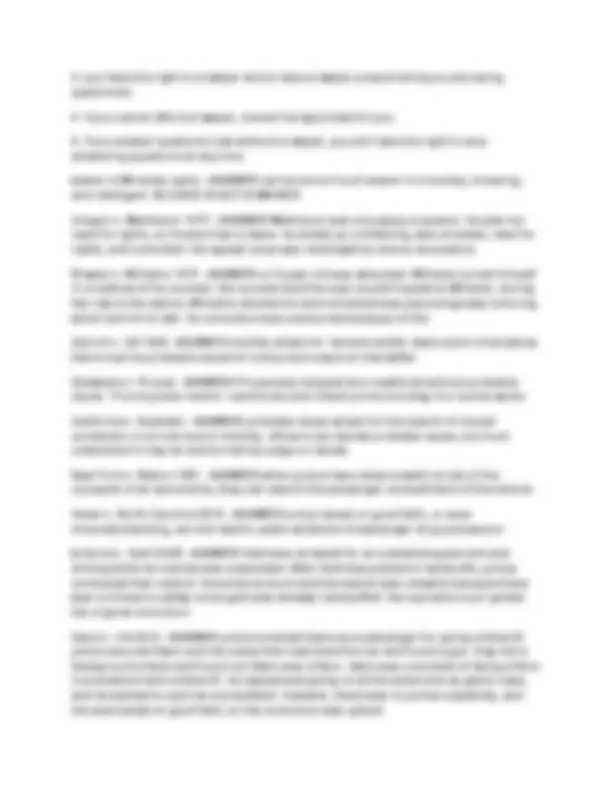




Study with the several resources on Docsity

Earn points by helping other students or get them with a premium plan


Prepare for your exams
Study with the several resources on Docsity

Earn points to download
Earn points by helping other students or get them with a premium plan
Community
Ask the community for help and clear up your study doubts
Discover the best universities in your country according to Docsity users
Free resources
Download our free guides on studying techniques, anxiety management strategies, and thesis advice from Docsity tutors
PA 241 Exam 2 Latest Update...
Typology: Exams
1 / 4

This page cannot be seen from the preview
Don't miss anything!



various models of policing - ANSWER include disorder control, crime control, class control, urban dispersion, broken windows, and communitarians
Chicago crime commission (1919) - ANSWER included a people processing system and focused on efficiency of the process. it lacked training and political affiliations
Wickersham crime commission (1932) - ANSWER Investigated problems associated with prohibition. it introduced treatment as well as rehabilitation. there was a lack of professionalism and some criminal corruption
United States riot commission (1960) - ANSWER focused on the effects of police tactics which may have led to existing problems
Omnibus crime control and safe streets act (1968) - ANSWER Focused on professionalization of police, created standardized training, infused policing with technical knowledge, and involved the community
Knapp 1972 - ANSWER NYCD investigation of corruption. New rules stated that commanders should be held accountable for their subordinates' actions, commanders should file periodic reports on key aspects that would breed corruption, field offices of Internal Affairs should be created at all precincts, undercover informants should be placed in all precincts, improve screening and selection methods and standards, a change in police attitudes
the police mission - ANSWER to enforce and support laws, investigate crimes/arrest offenders, prevent crime, and ensure domestic peace
crime prevention - ANSWER IS PROACTIVE. it aims to reduce crime/criminal opportunities, lower the rewards of crime
proactive activities - ANSWER include crackdowns and sweeps, sting operations, and profiling
brutality - ANSWER includes abusive language, coercion, and threats
Tennessee vs. Garner (1985) - ANSWER the use of deadly force is a seizure covered by 4th amendment. if anything, the situation must present imminent danger
types of misconduct - ANSWER misfeasance is the failure to perform duty PROPERLY. nonfeasance is the failure to perform duty AT ALL. malfeasance is performing illegal act
the Mollen Commission (1993) - ANSWER several NYPD officers revealed many acts of corruption
the Rampart Scandal (mid-2000s) - ANSWER a widespread corruption by many members of the LAPD's anti-gang unit. 100 falsely obtained convictions were thrown out, 20 LAPD officers left policing, and $70.2 million was paid in settlements
US v. Dunn 1987 - ANSWER states that open fields are NOT houses. even if a "no trespassing" sign is posted and the area is fenced, the area may not be protected
Chimel v. CA 1969 - ANSWER an incident led to Chimel's legal arrest. an intrusive search was conducted; this was unlawful. police are allowed to search only within their "wingspan"
US v. Ross 1982 - ANSWER a warrantless search of automobiles is okay only if probable cause exists for a stop
Kolander v. Lawson 1982 - ANSWER Lawson was stopped and refused to identify himself. over the next two years, he was stopped 14 times, arrested 5 times, convicted, and jailed. he sued police and challenged the law stating you are requiring to show an ID
Minnesota v. Dickerson 1993 - ANSWER Dickerson was leaving a crack house and acting suspicious. officers went over and conducted a pat down for weapons. there were no weapons, but there was crack. Dickerson was charged and convicted, but his conviction was overturned. from this a new law was created: plain feel/touch. this is a combination of stop and frisk with plain view
Rogers v. AZ 1996 - ANSWER there was a traffic stop NOT involving Rogers. Rogers and friends were watching from afar. officers saw them, went to ID them, they ran, and Rogers got caught. the officers pat Rogers down, and he had cocaine on him. he was convicted, and the conviction was appealed. the court said there had to have reasonable suspicion to believe there was criminal activity
Hiibel v. Nevada 2003 - ANSWER police responded to a domestic violence on the roadside. Hiibel refused to identify himself. he was then arrested for several domestic violence issues as well as inhibiting an ongoing police investigation. he was convicted, and his conviction was appealed based on the 4th, 5th, and 14th amendments
Royer v. Florida 1983 - ANSWER the DEA used a Drug Courier Profile to identify Royer. he was stopped and asked for his ID. the ID he presented did not match, so he was taken into questioning. he was then searched, and drugs were found. royer was convicted, and the conviction was appealed based on the 4th and 5th amendments
Miranda v. Arizona 1966 - ANSWER miranda was a suspect of kidnap and rape. he was interrogated, placed in lineup and ID'd, so he signed a confession. he was convicted, and the conviction was appealed based on 6th amendment: no counsel was present or offered
Miranda Warnings - ANSWER 1. you have the right to remain silent
US v. Carey 1999 - ANSWER the federal appellate court stated that the consent Carey had given to the police to search his apartment DID NOT EXTEND TO THE SEARCH OF HIS COMPUTER
US v. Turner 1999 - ANSWER the warrantless search of a personal computer while in the Turner's apartment EXCEEDED THE SCOPE OF HIS CONSENT
Florida v. Harris 2013 - ANSWER harris was stopped for expired license plates. the arresting officer had a drug dog, and the dog sniffed out stuff to make meth. harris was arrested. after some time, Harris was stopped again by the same cop/dog. the dog sniffed out drugs, but no drugs were found. harris tried to challenge his case, claiming the dog was unreliable. florida overturned the conviction, but then the supreme court reinstated it because the dog's record was above 95%
Florida v. Jardines 2013 - ANSWER police didn't have enough probable cause to search Jardines' house. a cop brought a drug dog by Jardines' house, and the dog sniffed at the front door and smelled drugs. this was unlawful; a sniff equals a search
Distinction between Jardines and Harris - ANSWER mobility!! harris' case was an automobile stop while jardines' case was a home search. since a home is fixed location, cops and drug dogs aren't allowed to search without a warrant
Florida v. Bostick (1991) - ANSWER Bostick was arrested multiple times and had license suspended, so he started taking public transportation. the cops learned his new routine and stopped one of the busses Bostick took regularly. they asked to search everyone's bags and saw Bostick had drugs. although the stop was unlawful and warrantless, Bostick's conviction was upheld because the cops did not coerce anyone. the search was completely voluntary
title 19 - ANSWER authorizes all checkpoints and stops such as border patrol and customs